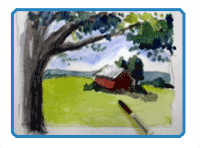
By Matt Fussell
Watercolor painting, originally termed "Aquarelle", was first popular in England. American artists like Winslow Homer, made watercolor a major medium for painting. Watercolor paint uses a gum binder and it's solvent is water. Watercolor painting typically uses transparent washes to achieve desired effects. Other water based paints such as acrylic, tempera, or opaque watercolor, are opaque in nature. (Although they can be thinned to achieve similar effects as watercolor.) White paint is generally not used with watercolor since the white of the paper is used to achieve tints and highlights of the painting. Therefore, watercolor paintings are usually planned out to a degree with a loose sketch in either graphite or ink.
Watercolor paintings can be completed on a variety of surfaces. Most commonly, watercolor papers are used. This special type of paper usually has a strong tooth, or texture, and is absorbent enough to accept many applications of watercolor paint without buckling or wrinkling the paper. Watercolor papers are categorized by weight. The weight refers to how much a ream of the paper weighs. For example, 80 lb. paper is thinner than 200 lb. paper. Watercolors papers can be manufactured as "hotpress" or "coldpress". Hotpress papers are smoother while coldpress papers are more coarse.
Other acceptable surfaces include illustration board and panel. Coldpress illustration board is a very heavy board with a finished surface similar to Bristol paper. The sheer bulk of the board prevents the water from wrinkling the paper. Gessoed panel is also acceptable for use with watercolors. Here again, the rigidness of the panel prevents wrinkling.
The hairs of watercolor brushes are either synthetic or natural. Natural hair brushes come from a variety of animals. Many artists argue that natural brushes hold watercolor for longer periods of time making brush strokes more fluid. While many artists prefer the qualities of natural brushes, others prefer synthetic brushes. Synthetic brushes carry a smaller price tag than natural brushes. Synthetic brushes are typically more durable than natural brushes as well. Try both types of brushes and decide for yourself what qualities are most benficial for you.
The following video tutorial demonstrates a watercolor painting of a barn on coldpress illustration board...
Here are some more art lessons that you may like...